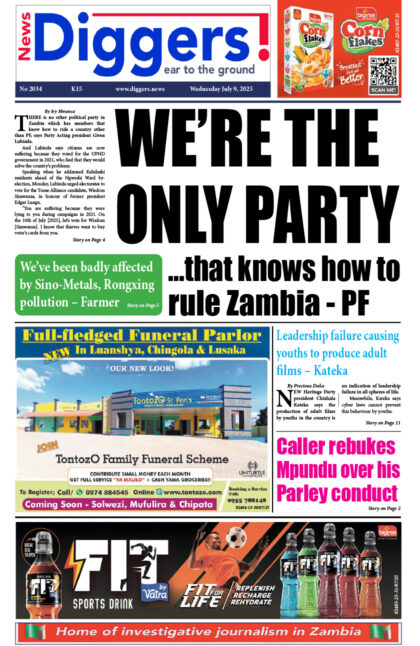ECONOMIST Chibamba Kanyama says the continued depreciation of the Kwacha against other convertible currencies is a huge blow to the country’s economy.
In Friday’s trading session, the kwacha breached the K15.00 psychological barrier against the US dollar for the second time in less than four months.
In an interview, Kanyama said the kwacha’s weak performance that saw it depreciate to K15 on average on Friday will have serious negative implications, especially that the Bank of Zambia recently maintained the monetary policy rate to try and cushion the effects the poorly performing local currency.
He said with the kwacha at the current rate, servicing of foreign debt will be at a much higher cost to the government, further putting a strain on the Treasury.
“The continued market-driven depreciation of the kwacha comes a week after the Bank of Zambia maintained the monetary policy rate. It is a huge blow to the BoZ itself because during the same period, inflation rate increased to 13.9 per cent. These are the same two targets the Policy rate should have been addressing and there is an increasing fear the next announcement will be marginally higher than 11.5 percent to counter these pressures. Whenever the market witnesses a movement of this kind of magnitude in the exchange rate, there has been government participation in the market and this obviously has to do with debt servicing. As long as debt repayments remain at the level they are or even higher as expected, the kwacha will be losing value,” Chibamba said.
“The immediate impact, and ironically so, is on the increase in debt servicing levels in kwacha terms. In other words, government is the first to pay a huge price for any devaluation because of the debt stock denominated in foreign currency. The other factors that move the exchange rate leading to kwacha loss have to do with huge jumps in imports, maturity of government securities where foreign investors fail to reinvest as well as dividend declarations by foreign owned companies. Imports are currently off peak, more so with the Coronavirus that has affected one of our major trading partners, China.”
He feared that the continued depreciation of the kwacha may affect the prices of essential commodities like fuel.
“The other immediate impact with the current devaluation, unless temporary, is the price of fuel. Fuel is very sensitive to the exchange rate as we hardly hedge against such eventualities. Zambia largely buys fuel on spot price, meaning we have a product that is exchange rate sensitive. If the rate remains another two weeks, we should expect the Energy Regulation Board responding with some marginal increases, [and] we have very low foreign reserves at the moment. Ten years ago when we had nearly four months of import cover, government would absorb the impact of the exchange rate for at least 60 days; not any more – even two weeks is an anticipation too long to sustain operations for oil marketing companies and Indeni,” Kanyama said.
“Aside from government, many companies with imported inputs will begin to feel the knock-on effects of the exchange rate. You may not know but there are companies in Zambia that have been quietly winding up operations by either absorbing loss making entities into other businesses or closing shop altogether. The most hit are those companies with price elastic products where demand falls by a marginal increase in price. Most of them are slowly downsizing because on one hand, they are facing rising interest rates and on the other, falling demand. Their margins are seriously squeezed and threatening job security for thousands of employees.”
He urged the government to use the anticipated visit of the International Monetary Fund (IMF) team to Zambia this month to come up with solutions to the current economic instability.
“High inflation and an unstable exchange rate are enemies of economic growth. Without medium term stability in these critical variables, industry that contributes towards economic growth will experience a huge slump in 2020 and this will threaten other government targets such as achieving a growth rate of three percent, reducing the deficit from the current seven per cent to 5.1 per cent, reducing both domestic and external debt, including arrears as well as achieving a revenue target of 22 per cent of GDP. We also see ourselves failing in building up foreign reserves to more than two months of import cover,” said Kanyama.
“We hope the anticipated visit by the International Monetary Fund will be fruitful. We are all very keen to see a realistic solution to our current macroeconomic instability and the IMF offers that level of confidence by all market players, Eurobond investors included. Minister of Finance Bwalya Ng’andu needs to demonstrate that Zambia is fully committed to reaching debt sustainability levels sooner than later so that he finds common ground with the Fund. If this does not happen, we will have quite a difficult year and we pray this should not happen.”




















One Response
As an Economist why can’t you provide solutions to this problem unlike busy telling us the performance ? Tell Kanyama and his economical associates to provide solutions.